THE CUP THAT CHANGED EVERYTHING
If the 1980 America’s Cup saw the birth of professionalism with Dennis Conner’s Freedom campaign executing some 4000 hours of training, by 1983 the game was changing, and the technological playing field was getting more even.
Lessons had been learnt by the Australians in 1980 and in the immediate aftermath of defeat, Alan Bond jumped aboard the yacht, corralled the crew, and re-set the dial on the Australian challenge for the America’s Cup, as John Bertrand recorded in his book ‘Born to Win’ some years later:
“Don’t worry boys,” he yelled. “That was great, we gave it our best shot.” He did not seem to give a damn whether we had won or not. But Bondy is nothing if not very, very astute, and my mind flashed back to that conversation where he hinted that 1980 was just a low budget holding action, and that 1983 was what would count. As we approached Newport Harbour, Bondy assembled the crew and confirmed what I had suspected. “I have decided,” he said, “that we are coming back in 1983 with a major challenge. We’ll have the budget and the boat. And we are going to win the America’s Cup. Right?” The guys cheered and clapped. “Ben Lexcen will design the boat and my skipper and helmsman will be John Bertrand.”
Whilst the Australians plotted, Dennis Conner went to work on a relentless vision for the 25th defence of the America’s Cup for the New York Yacht Club but structural campaign issues were embedded early that he, and the club would later regret.

Dennis Conner 1983 in an AMEX ad campaign
Sparkman & Stephens were once again retained as designers alongside Johan Valentijn and the two design offices went about building the first two new boats of a three-boat campaign for Conner. ‘Magic’ designed by Valentijn was built at one end of the rule and actually never qualified as a 12 Metre being just 43 feet on the waterline where the rule stated a minimum of 44 feet. ‘Magic’ was rapier fast in the pre-start circling and could tack on a dime but struggled to hold height and pace over a distance. ‘Spirit’ was at the other end of the scale. Heavy with a high displacement, she was a boat that could grind on long legs but stuck in tacks and gybes and when measured against the 1980 winner ‘Freedom’ proved to be deficient.
‘Spirit’ went into the shed for extensive modifications in the winter of 1982 whilst Johan Valentijn was tasked with the job of designing the third new boat for Conner, combining input from all three boats of the syndicate – Freedom, Magic and Sprit – plus sailor’s input from Conner, John Marshall and Halsey Herreshoff. With his designs constrained, the resultant boat was ‘Liberty’ and early sea-trials were a disaster with a tendency to hobby-horse in chop and couldn’t keep pace with ‘Spirit’ in a breeze. She was returned to the builder’s yard for extensive underbody work, having her aft overhang reduced by three feet, the keel moved forward, and internal ballasting addressed.
It was the last of these modifications that produced the first real controversy of what ended up being an acrimonious Cup in 1983. Liberty persuaded a complicit New York Yacht Club to allow for the boat to have three rating certificates so Conner could effectively select the mode for the boat to any given condition. The challengers protested but the club waived it through and allowed Conner to adjust displacement from 54,500lbs to 55,700lbs on any given day.
As the 1983 Cup neared, the defender selection trials saw three syndicates come to the line. John Kolius and the American John Bertrand re-vamped the old Cup warhorse ‘Courageous’ convinced by her un-tapped potential in the hull whilst Tom Blackaller and Gary Jobson had secured funding from an IBM heiress to build a new Dave Pedrick design ‘Defender’ that was very much at the smaller end of the rule with a 44-feet 6-inch waterline and proved to be nimble in the pre-start and certainly could out-tack ‘Liberty’ in a match race.
The defence trials were remarkably close through July, August and September 1983 with each boat revelling in their own conditions, but it was ‘Defender’ that was the first to be excused by the NYYC Committee at the end of August. Courageous and Liberty went head-to-head with the older boat having every chance of defeating its money-no-object, new build rival that struggled in lighter airs but a three-race winning streak over two days gave the America’s Cup Committee the perfect opportunity to discount ‘Courageous’ and award the defence slot to Dennis Conner’s ‘Liberty’ in what many saw as a foregone conclusion from the very start.
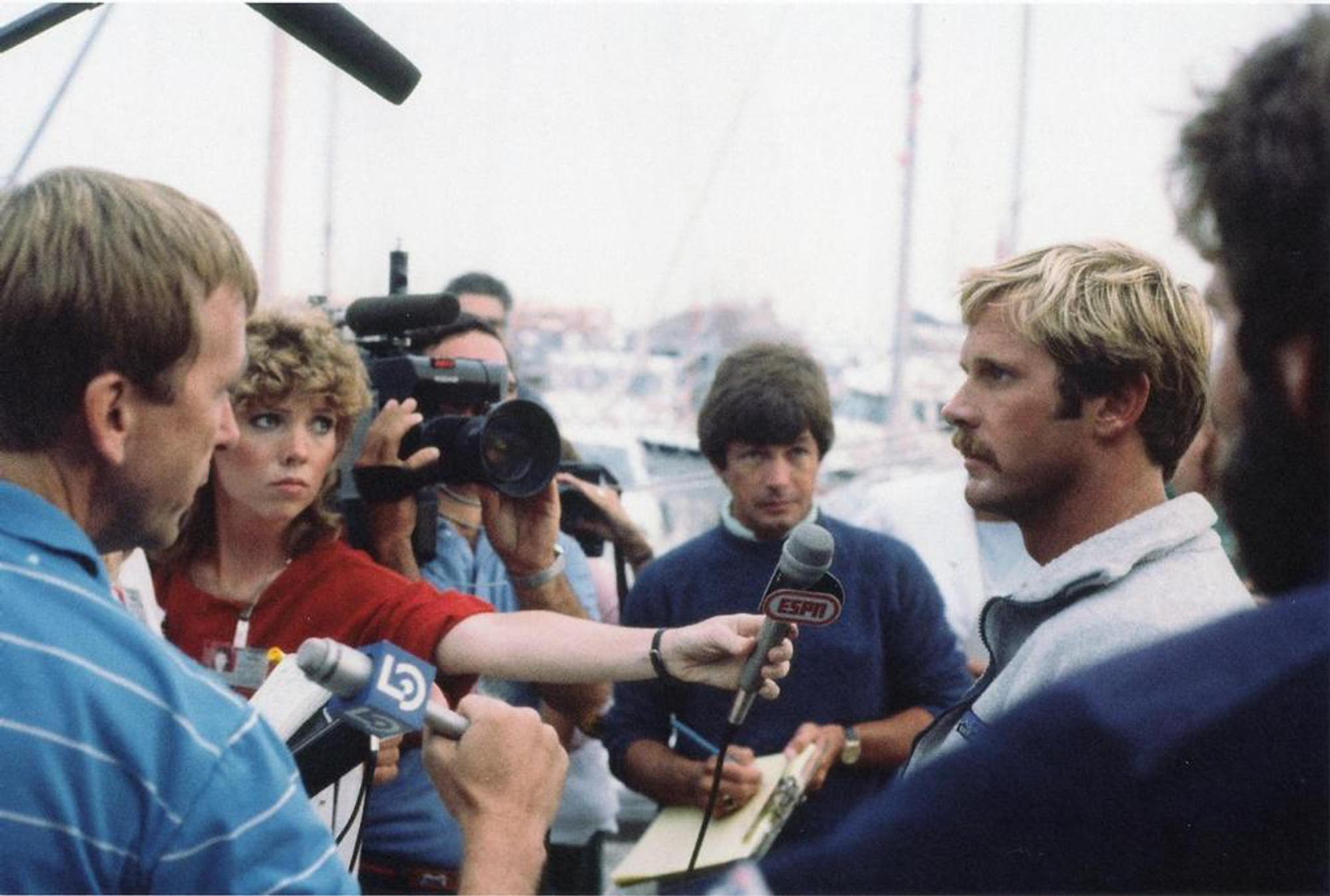
John Kolius the very able skipper of Courageous in the Defender Trials, who was eliminated after losing two races in one day to Liberty. © Maritime Productions LLC
As the defence trials raged through that summer, even fiercer competition was to be found in the seven-strong challenger trials. Italy entered for the first time with Gianni Agnelli, the famed matriarch of the Fiat empire, inspiring a nation with the ‘Azzurra’ syndicate. Canada returned to the America’s Cup for the first time in 102 years whilst Peter de Savary, the archetypal ‘swashbuckling’ millionaire, always with a cigar to mouth, backed the Victory ’83 campaign for Great Britain.
Australia came with two syndicates both off the design board of Ben Lexcen – ‘Challenge 12’ and ‘Australia II’ plus an under-funded campaign off the design board of Alan Payne, ‘Advance.’ Early on, Challenge 12’s campaign needing an 11th hour rescue from Alan Bond before new funds were found from Melbourne businessman Dick Pratt but Bond’s largesse was tactical for he knew he needed a good trial-horse for his radical Australia II and Lexcen had designed Challenge 12 to be a step-on from the defeated Australia of 1980. ‘France 3’ was the seventh challenger backed by the producer of the controversial ‘Emmanuelle’ film Yves Rousset-Rouard and led by the mercurial darling of French sailing, Bruno Troublé.
Australia II was the boat that everyone feared. From the outset, the Australians insisted on maximum security around the design, shrouding the keel from view and frustrating not only the challengers but the defenders too. The genesis of the design is worthy of note. Ben Lexcen started work immediately after the 1980 Cup had concluded with a theory that to win, the boat had to be as close to the minimum 44 feet waterline whilst having maximum sail area and addressing concerns around stability and leeway. Lexcen’s determination was to get ballast as low in the boat as possible, but he needed accurate modelling to achieve this. Up to 1980, the Australians had used the tank testing facility at Sydney University but for the 1983 campaign they turned to Peter Van Oossanen, a Dutch national who had spent considerable time in Australia, who advised using the vastly expensive Ship Model Basin at Wageningen.
Lexcen travelled to the Netherlands’ facility to start work on what would become ‘Challenge 12’ whilst retaining the ethos for Australia II and began testing upside down keels with the base larger than the area affixed to the hull and started to explore winged keels with the added advantage of low leeway and increased stability. Size of wing was ultimately the determinant and by the summer of 1981, Lexcen presented his thinking to Alan Bond who immediately jetted into Holland with John Bertrand and key lieutenants of the campaign to review the breakthrough thinking.
Upon seeing the design, initially the sailing team were downcast after insisting on having just an equal boat to the Americans. Lexcen and Bond knew that it was an almost impossible task to take on the well-prepped Americans in their own back yard in just an equal boat. The results of both the computer simulation and tank testing in Holland came to precisely the same conclusions. In Australia II they had what they believed to be a rocket-ship and as Bertrand later wrote in ‘Born to Win’: “I was worried that the tests did not take into account variations in rough water and the Newport slop, but I had to agree that the results of these tests were so overwhelming that we would be crazy not to build this boat. Benny was beside himself with excitement, his tests proved that this new boat would be 5% better than any conventional boat going to windward. “We're not just going to win the America's Cup,” he exclaimed “we're going to win it by miles. We're going to win some of these races by 20 minutes!”
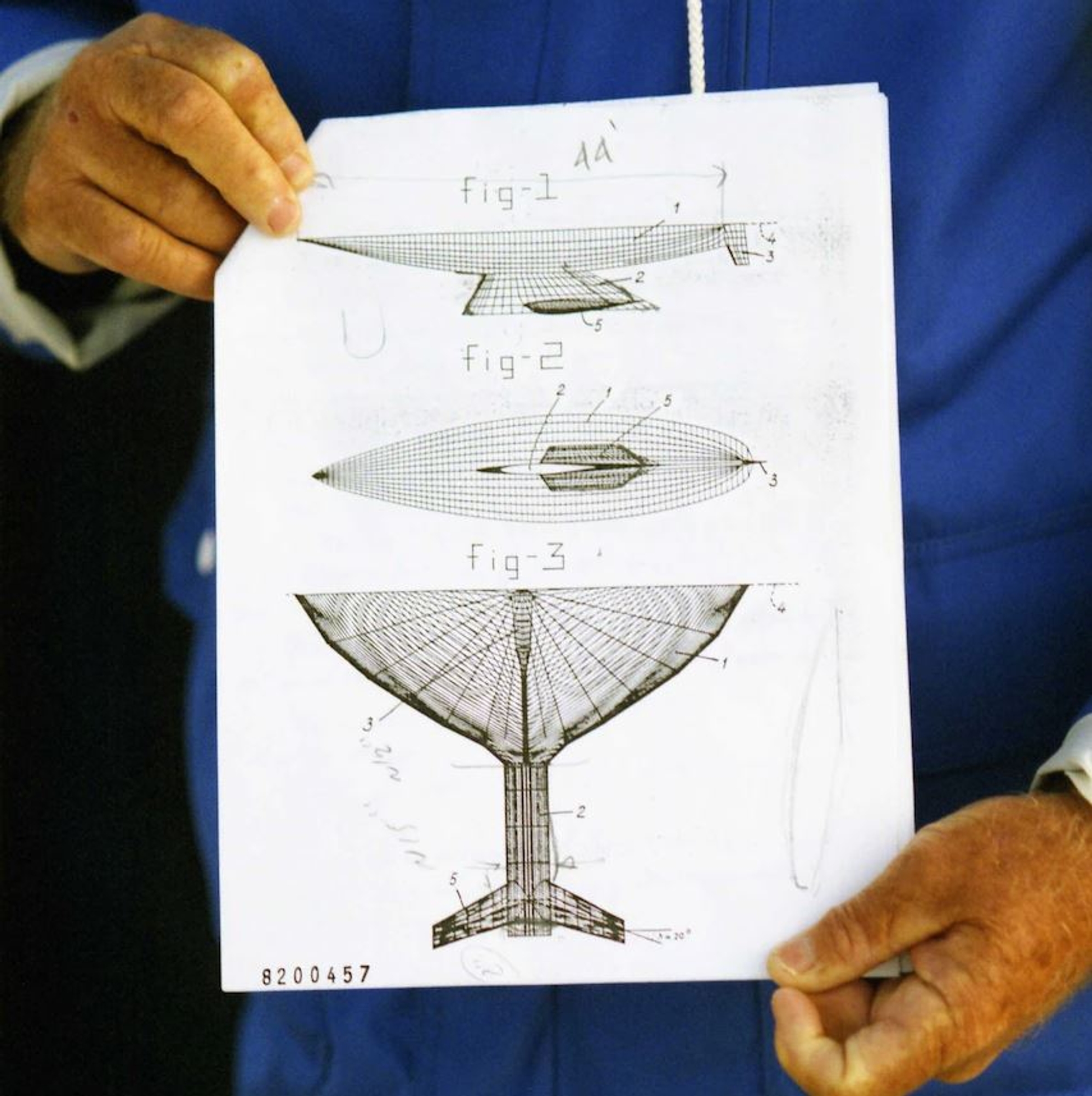
Ben Lexcen's winged keel design caused an uproar in the New York Yacht Club.()
Bond ordered the boat to be built by Steve Ward’s yard in Cottesloe, Perth, Western Australia with a mantra of ‘Lexcillence’ – every detail mattered. The winged keel’s pattern was made at workshops in Sydney and shipped to the State Engineering Works foundry in Perth where it was cast in one piece and built oversized so that it could be precisely hand-finished.
Meanwhile the Australian team made another crucial move to success in the hiring and nationalisation of New Zealand nuclear physicist Tom Schnackenberg, arguably the foremost authority on Twelve-Meter sails and an employee of North Sails. Everything was coming together for the Australians with a team of experienced Cup sailors more than capable of handling the pressure whilst going toe-to-toe with the Americans. But first the Louis Vuitton Challenger Selection Trials had to be navigated successfully.
From the very outset, Australia II was clearly a class apart from the rest of the Challengers in 1983. The early under-weighted opening round robins saw Challenge 12 perform well but as the likes of Azzurra, Victory ’83 and Canada I showed significant improved, the Lexcen base-case boat wilted, and she was eliminated alongside her fellow Australians in Advance, and France 3.

Australia II (left) with its keel hidden behind coverings at the dock in Newport.()
Australia II topped the leaderboard into the all-in semi-finals and after notable successes across a wide wind range, entered the final eliminators with a record of: sailed 49, won 44. Meeting her in the final was Victory ’83 with the mercurial talents of Lawrie Smith and Rodney Pattisson in the afterguard and after some brilliant tactics in the pre-start gave the British an early 1-0 lead, it was all Australia II from there and she closed out the Challenger Eliminators 4-1. Australia II was on her way to the America’s Cup Match of Matches.
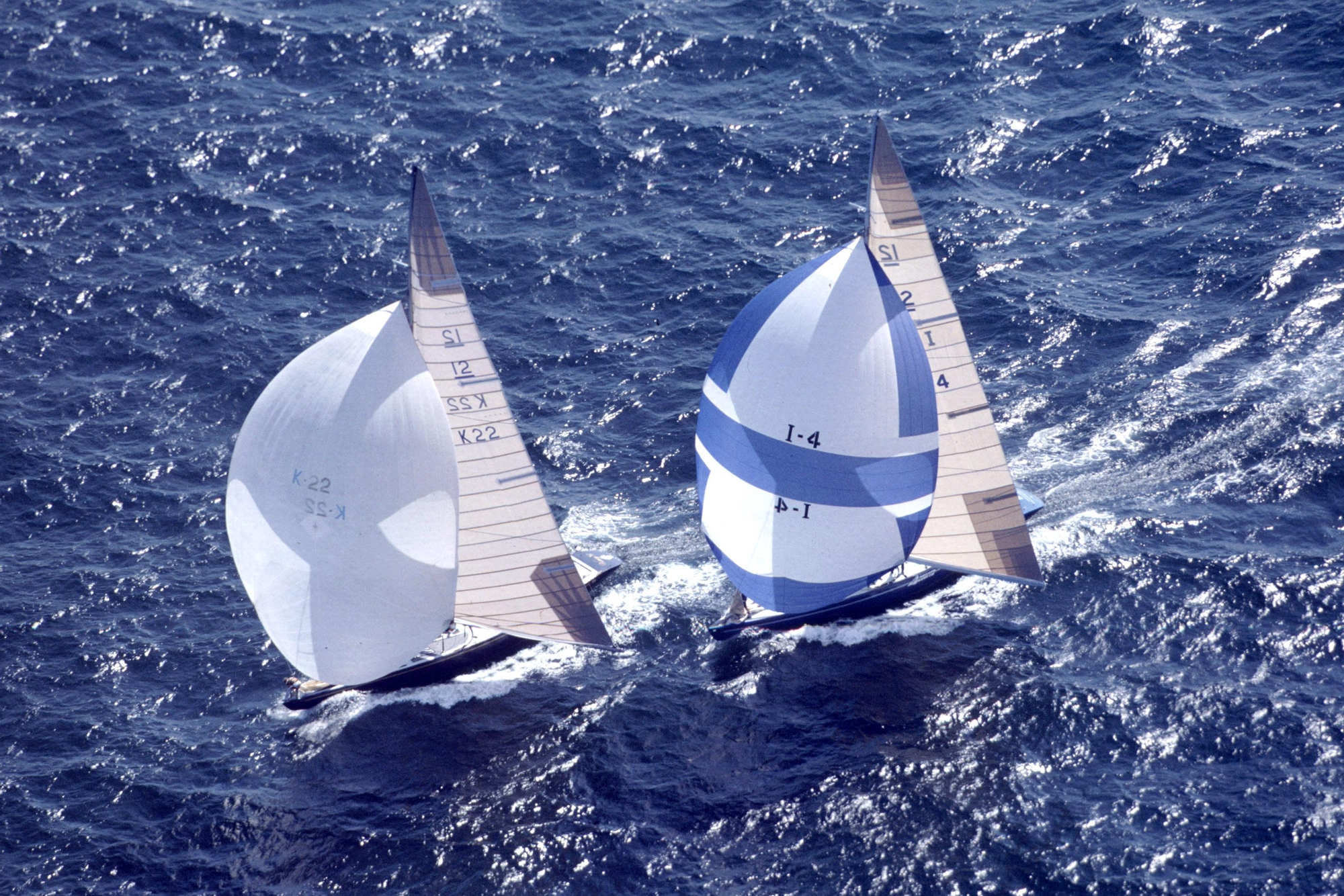
Victory 83 Challenge vs Azzurra Cedit: Carlo Borlenghi
The way that Australia II had won in the Challenger Series raised serious concerns among the NYYC America’s Cup Committee and the psychological effect of keeping the winged keel shrouded raised rumour and speculation about the boat’s legality. Furthermore, the provenance of the yacht was questioned and in particular whether Ben Lexcen had designed the boat himself or whether the influence of the Netherlands Ship Basin and the Netherlands Aerospace Laboratory that Lexcen had used for analysis conformed with the ‘designed and built’ stipulations of the Cup.
Australia II had been measured in Australia by Ken McAlpine with her rating certificate issued by the IYRU and endorsed by the Australian Yachting Federation. When the boat had arrived in Newport, the challengers and indeed the defender, the NYYC, had the right to visit the shed at Cove Haven Marina where the three-man measurement committee conducted their measurements. Much to their later regret, no-one showed up. It was yet another blow to the defence of 1983.
After that missed opportunity, the NYYC then waged war on the Australia II team, coming from several angles, most prominent being on the sheer legality of winged keels and the simple fact that when heeled, producing a deeper draft than when measured in an upright position. However, the more the club protested, the greater the public attention was attracted through various press articles drawn to the competition and their seeming unsportsmanlike conduct. An early submission from the NYYC to the United States Yacht Racing Union asking for an interpretation on the 12 Metre Rule gave surprisingly accurate numbers around the keel dimensions of Australia II, further enhancing suspicion of clandestine operations in place.
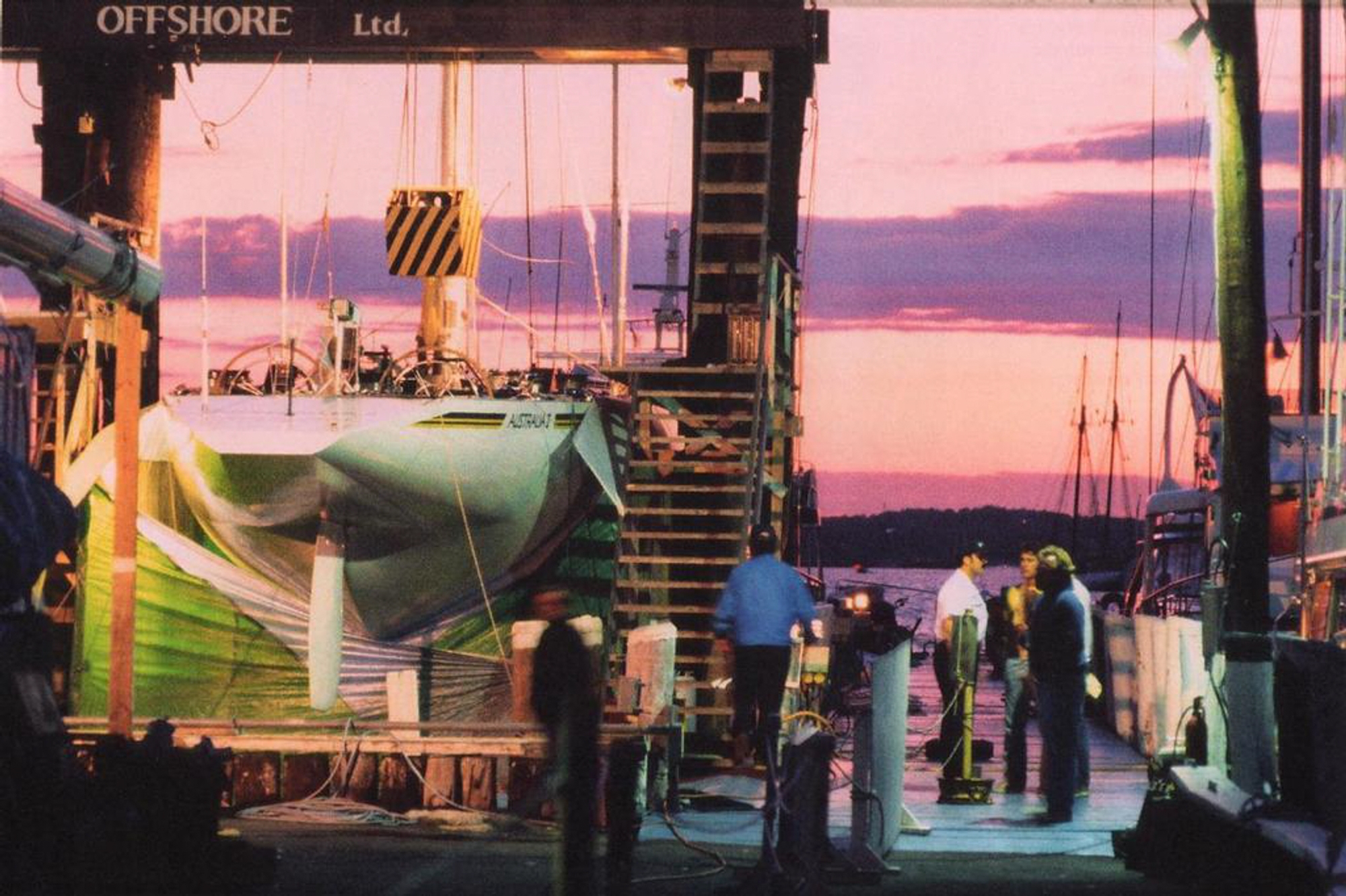
Australia II was protected by her skirt right through the regatta © Maritime Productions LLC
It was a long summer through to the start of the Match with both sides launching offensives and counter-offensives. The Americans were relentless in their pursuit of illegality on all fronts, but wise heads prevailed even at the very last when the NYYC America’s Cup Committee met onboard Bus Mosbacher’s motor launch ‘Summertime’ with the power to call off the whole America’s Cup in its entirety. The nine-man committee had a split vote and, in that moment, held the future of both the America’s Cup and the New York Yacht Club in its power. The Cup survived. Just.
Tuesday, September 13th, 1983, was the start of a momentous series. Australia II emerged from its Newport Offshore base to the thunderous tune of Men at Work’s ‘Down Under’ and a huge boxing kangaroo flag. Liberty slipped its mooring at the Williams & Manchester Yard to the tunes of ‘Chariots of Fire’ and the ‘Empire Strikes Back.’ These were two sporting teams at the peak of their powers, pulling every psychological trick in their armoury and going toe-to-toe for the grandest prize in international sport. The weather, however, wasn’t playing ball on the 13th September 1983 and racing was abandoned for the day just as breeze began to fill with the time-limit being held up as precluding the contest.
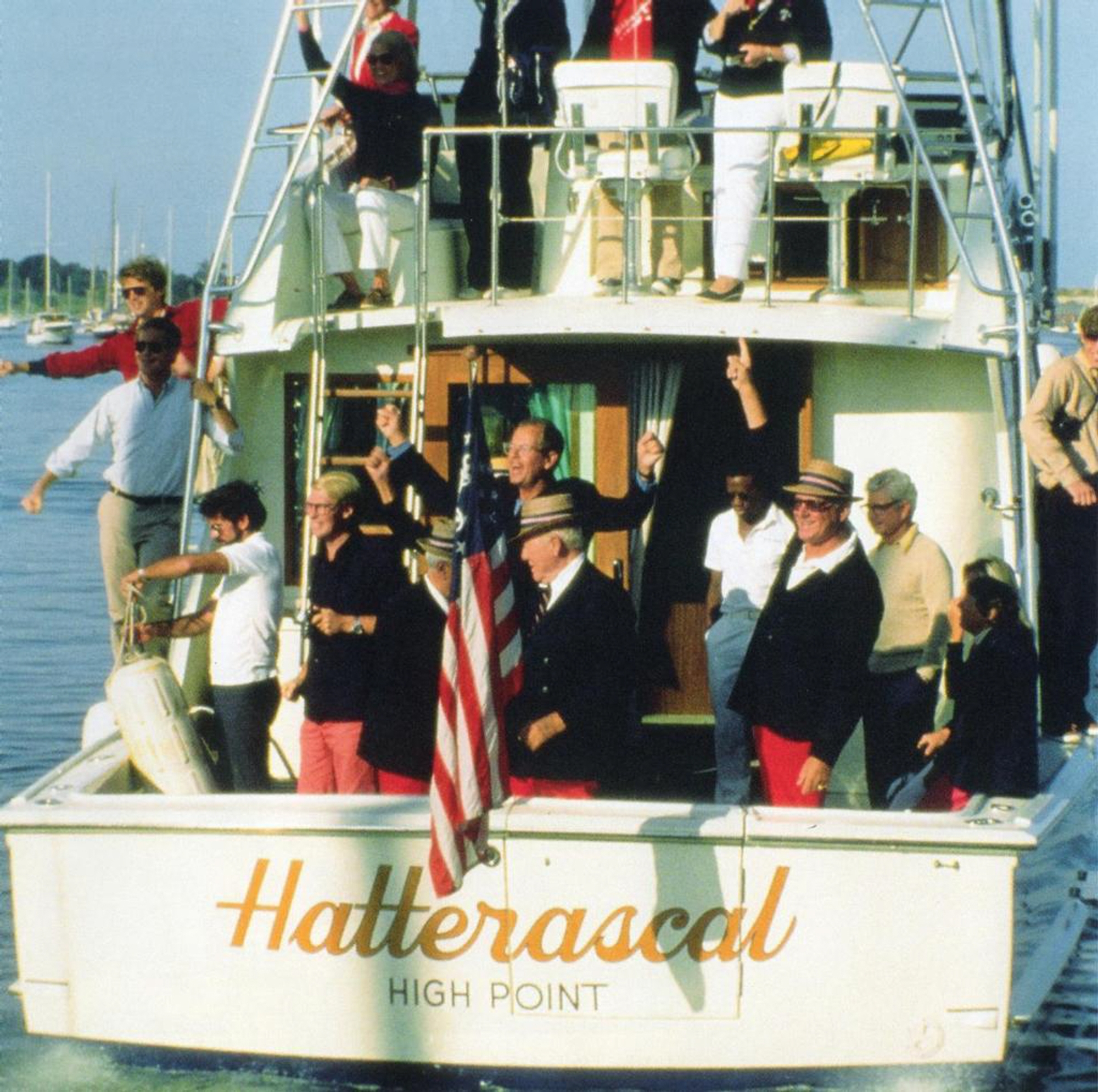
Watching Liberty leave, New York YC Commodore Robert Stone cheers with hands upraised, Commodore Bob McCullogh signals "number one" © Maritime Productions LLC
The next day, before a fleet of over a thousand spectator boats, helicopters, fixed-wing planes, and the Goodyear blimp in the skies above, was a classic. Australia II showed her manoeuvrability in the pre-start, tying Conner up in knots and started three seconds ahead, holding the leeward station as both boats headed out on starboard tack. Conner was forced away after less than two minutes and carried out on a long port tack with Bertrand covering. Eight minutes later, Liberty tacked, and Australia II went for her lee bow, forcing Conner again to tack away. By the time the two boats came back together, Bertrand knew that he had the edge and despite being on a collision course, bore under Liberty’s stern to hold the strategically important right-hand side of the course in the crucial last phase of the beat. A small tacking duel ensued in the final yards to the mark, but the Australians stole the lead, sailed Conner past the mark on port, and rounded with an eight second lead.
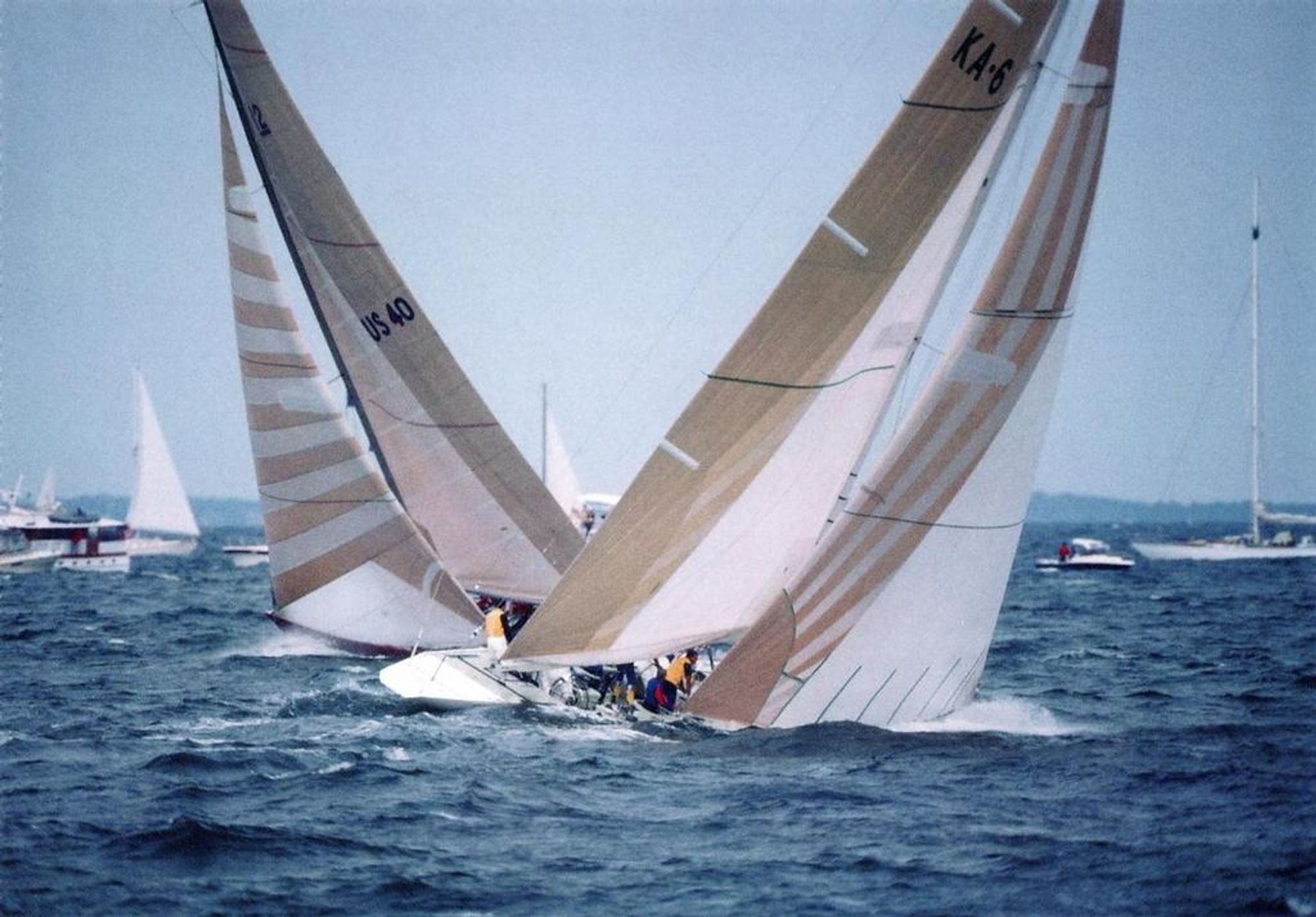
Liberty covers Australia II on the sixth leg of Race 1 in the 1983 America’s Cup Paul Darling Photography Maritime Productions
The first reach was unremarkable with both boats holding station but a wide rounding at the wing mark and a sharper exit gave Liberty the advantage on the second reach to the leeward mark and enabled the Americans to sit on the Australian’s wind, collapse their kite and sail into the lead. At the leeward mark, the delta was 16 seconds and up the next beat, Conner was relentless and immaculate in his close cover over 21 tacks to round the top mark with a 28 second lead. A gybe set handed the advantage back to the fast-charging Australia II and after a bear-away set, they quickly shadowed Liberty and drew closer down the middle of the course in better breeze. Liberty gybed over and gybed back, before taking an aggressive move on starboard gybe across Australia II’s bow and forcing Bertrand into drastic avoiding action.
At the crucial moment, a large bang was heard on Australia II as a block containing the steering cable sheared and suddenly Bertrand only had the trim tab on the aft of the keel to try and maintain control as the mark loomed. Quick thinking crewmembers dived below to fix the problem and somehow the Australians made it around the leeward mark and with a temporary fix in place initiated a fruitless tacking duel to try and claw back to Liberty. It wasn’t to be, and it was first blood to the Americans by 1 minute 10 seconds.
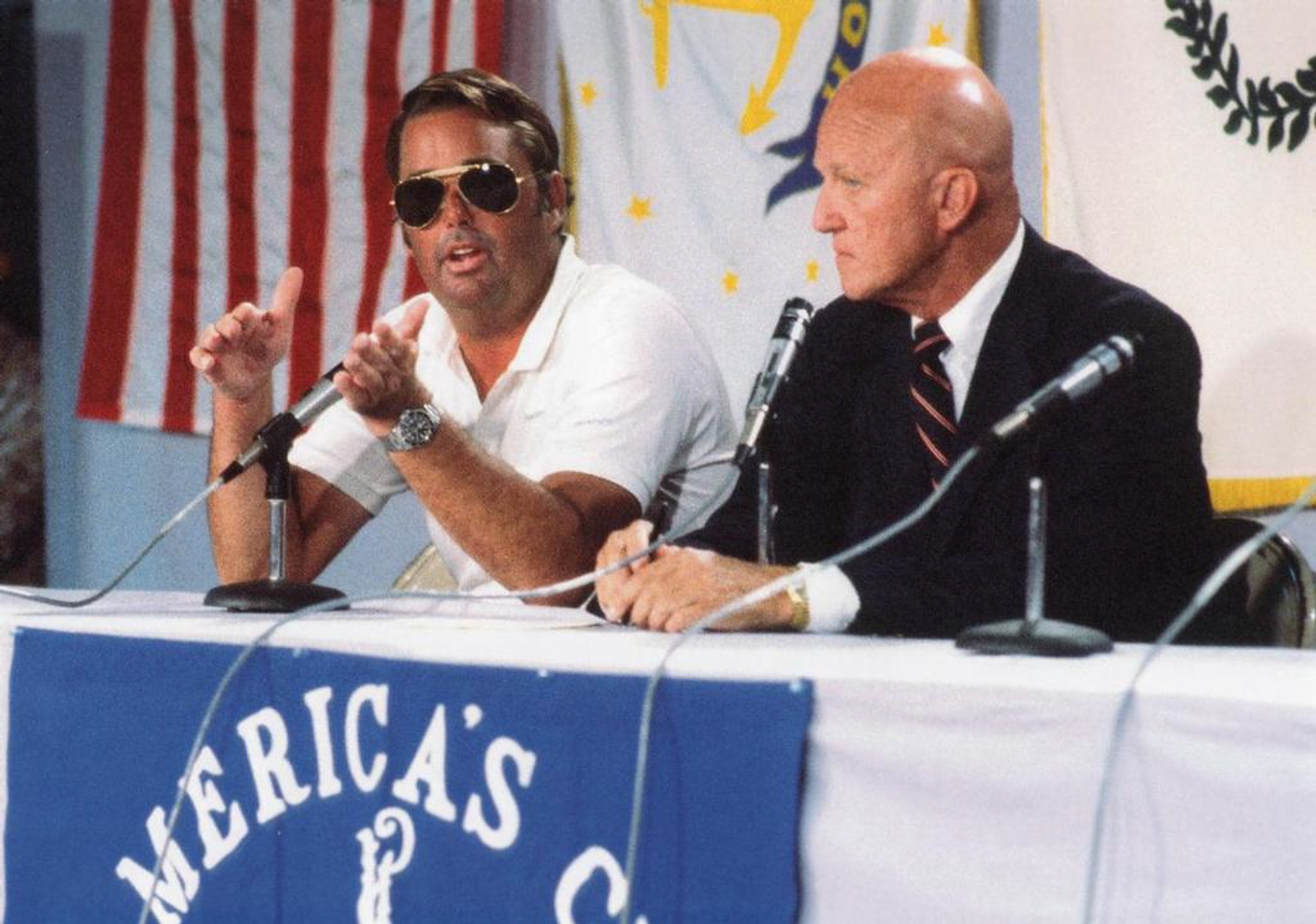
Dennis Conner goes over Race 1 tactics, Bill Ficker is the moderator © Maritime Productions LLC
No less dramatic, race two was held the day after on the 15th September 1983 with Dennis Conner looking to keep maximum pressure on the Australians. Knowing that he had a boat that was slower to manoeuvre in the pre-start, Conner and his tactician Tom Whidden chose a ‘run and hide’ strategy that kept Australia II tailing them before slipping their clutches in the final countdown to the start and managing to secure the lee bow position to leeward and forced Bertrand into an early tack. Australia II again was contending with gear damage with the headboard car of the mainsail beginning to part company at the area around the halyard lock and stopping the Australians from fulling hoisting.
However, with the favoured right-hand side of the course, Australia II took an early lead in a veering 17-knot wind that at times gusted through at 20-25 knots but this was a leg of attrition with an epic tacking duel, initiated by Conner, in the final stages to the windward mark that favoured the fast acceleration of Australia II who took a lead of some 45 seconds at the first turn.
With Colin Beashel sent up the mast to try and repair the headboard car over the two reaching legs, and the powerful Liberty with its longer waterline eking up from behind, Australia II changed down to a half-ounce spinnaker as the wind began to fade towards the leeward mark but upon rounding, and the mainsail still not at full hoist, Australia II were sitting ducks as Liberty eked ever closer.
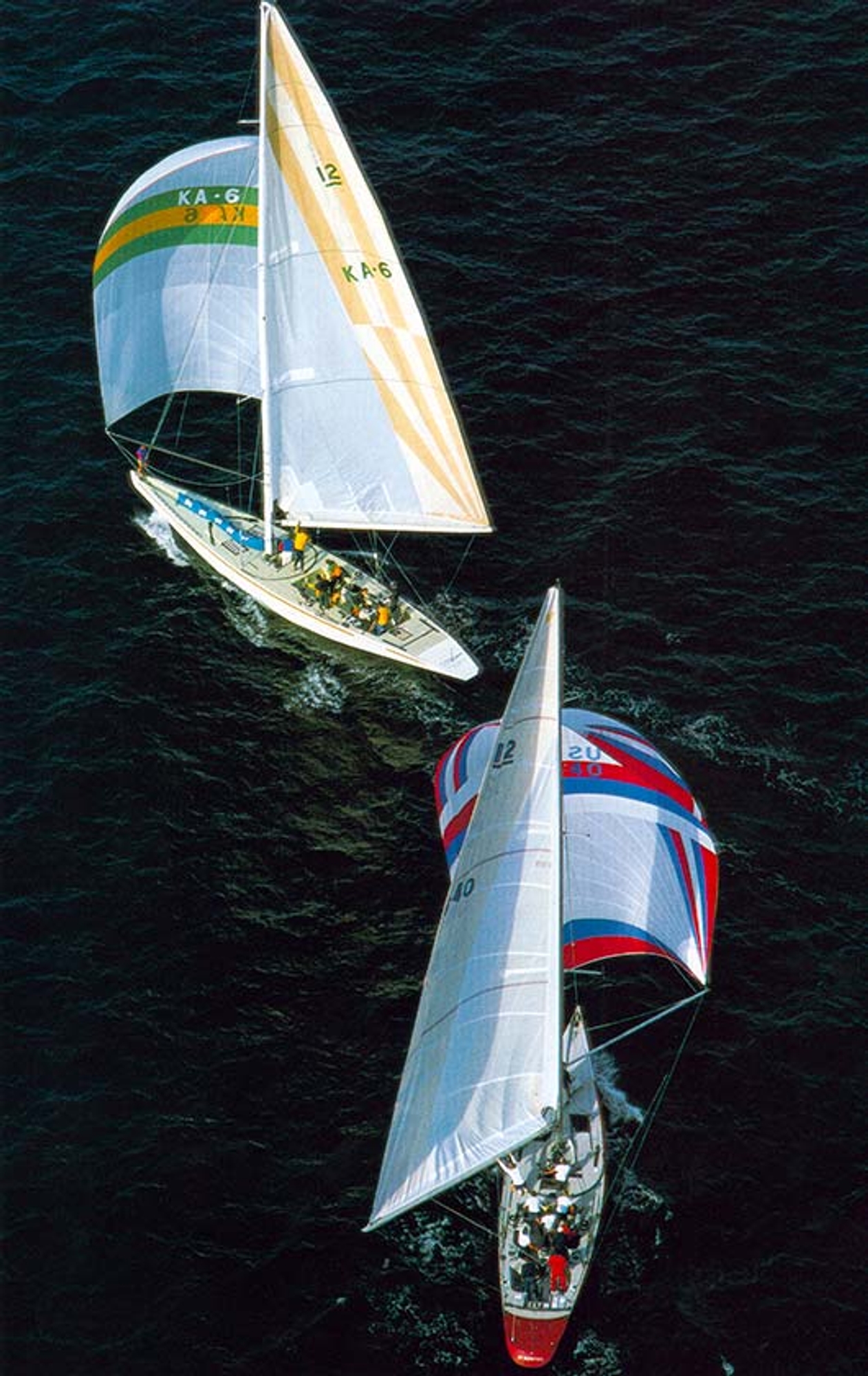
Australia II leads Liberty
A protested slam-dunk, executed by Liberty almost recklessly, and acknowledged gracefully by Halsey Herreshoff, saw them seize the lead on the second beat in almost desperate conditions and the big red boat clicked into the sea breeze out to the right first and rounded the final windward mark with a 48 second delta. Australia II came back on the run by 17 seconds but Conner and Whidden, master tacticians in light Newport breeze, held the right-hand side on the final beat to the finish and gave Australia II the only option but to chance their luck out left and trail home 1 minute 33 seconds behind. Conner threw a salute to the NYYC Committee boat that riled the Australians, but they were 2-0 up and looked in complete control of the Match.
The aftermath of race two saw the slam-dunk protest dismissed and then a curious affair with Liberty announcing their intention to raise the ‘N’ flag to request no racing the next day and then failing to do so by one second outside the time-limit. Australia raised their ‘N’ flag one second within the time-limit, and the lay day was counted as being called by Australia who protested and felt that the lay-day request should have stood with Liberty. It was a sign of the growing acrimony that had lingered over the 1983 Cup.
After the lay-day, both boats came out for race three on the 17th September 1983 to be greeted by 10 knots of breeze and Australia with a point to prove having felt that poor luck had dogged them in the opening two races and recognising that they had a rapid boat that was very much the measure of Liberty. The pre-start was a tame affair with Conner running away deep into the starting box and almost handing the lead-back to the line on a plate for Bertrand as both boats fluttered their sails in a classic time-on-distance. Australia II to windward led Liberty to the middle of the line, wound on her sails and tacked over to the Committee Boat, starting 11 seconds clear.
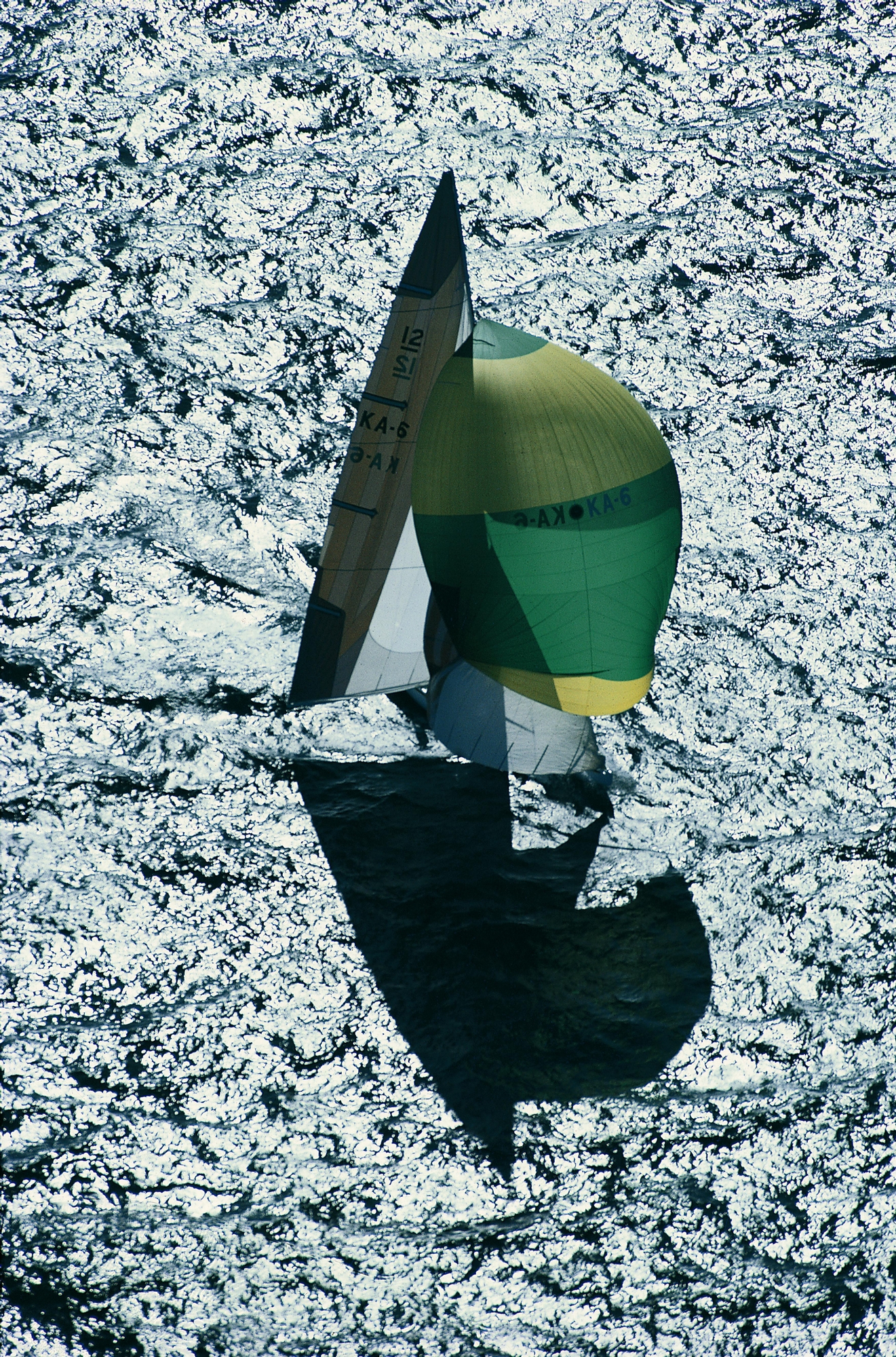
Australia II in the lead Credit: Carlo Borlenghi
A beat that saw some 22 tacks ensued and in the perfect conditions for Australia II she drew further and further ahead. The delta at the top mark was 1 minute 15 seconds that was further extended out to almost six minutes by the final leeward mark but with the wind shifting and then dying, the time-limit came into play and the race was abandoned with at least two miles of the final beat left to complete.
No matter the abandonment, the Australians were high on their performance and a newfound confidence built into the team ahead of the re-run race three on the 18th of September 1983. In 7-8 knots of southwest breeze that had switched from the early afternoon north north-westerly, the pre-start concluded with Australia II right on the lee bow of Liberty and ahead. A quick luff just before the line forced Conner to tack away for the starboard end of the line where he just cleared the anchor warp of the Committee Boat, but Australia II crossed the line at pace and was able to cover immediately from a position of strength. Both boats headed out to the right-hand side of the course on port tack for some 22 minutes before an 11-tack duel yielded a 1 minute 14 second delta at the top mark for the Australians.
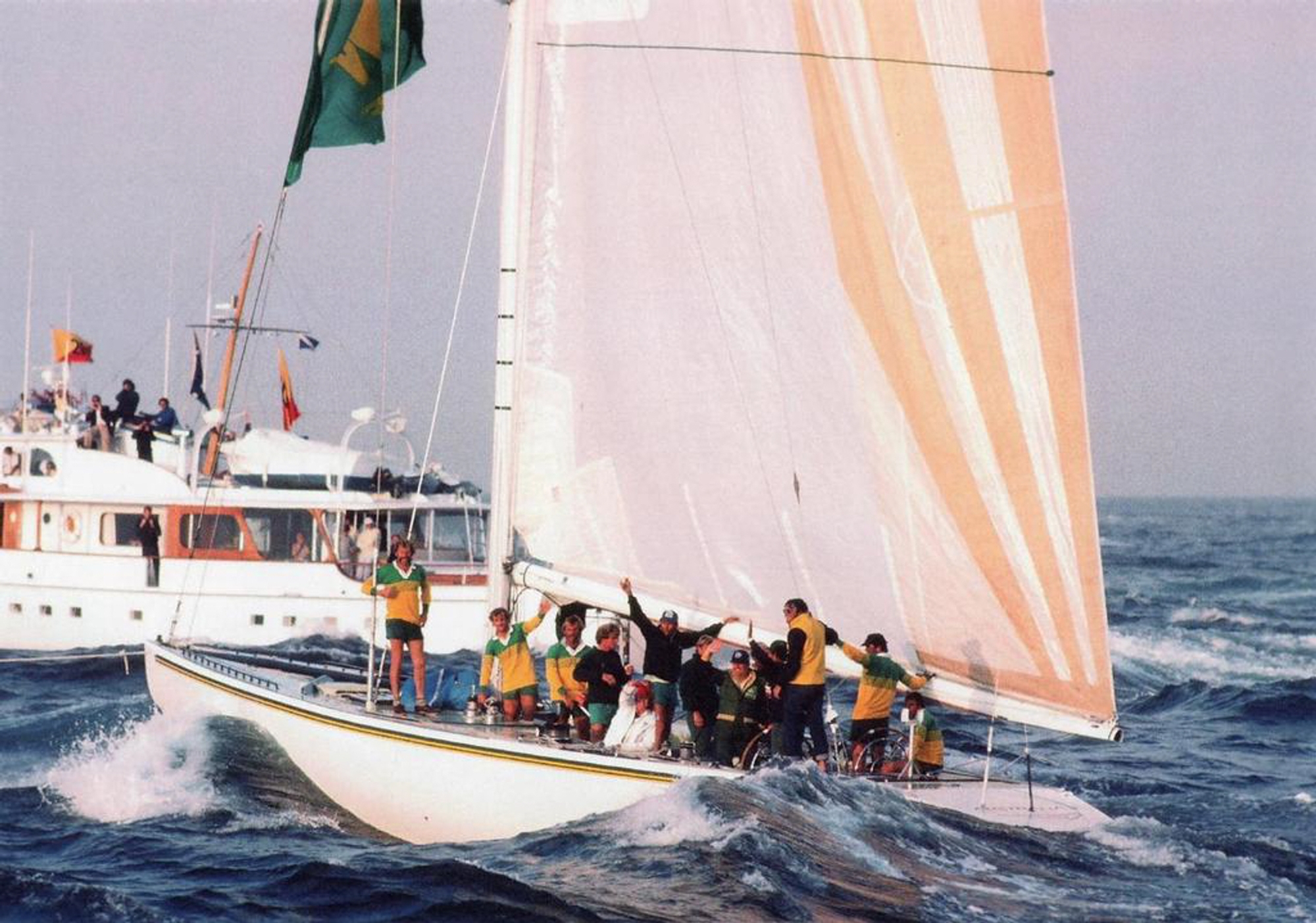
Australian II’s crew is in high spirits on the tow back to Newport after their easy Race 3 victory
Liberty used her waterline and powerful spinnakers on the two reaching legs to close the gap to 43 seconds at the first leeward mark and then dictated a 33-tack duel up the second windward leg. Bertrand covered relentlessly and, on every tack, gained a small margin. By the top mark Australia II was back out to 1 minute 15 seconds and then some deep VMG running with their narrow spinnaker saw the Australians round the final leeward mark with a healthy 2 minute 47 second delta. Knowing that there was little chance to beat the Australians on their day, Conner was quiet on the final leg to the finish with Bertrand covering his every move after a smart two tacks around the leeward buoy put him in the command windward position. The winning margin was 3 minutes and 14 seconds. Momentum was shifting. Belief was coursing through the Australia II camp.
With his back to the wall, Dennis Conner, ‘Mr America’s Cup’, produced one of the finest tactical displays in race four on the 20th September 1983 after a lay-day called by the Liberty team. In the pre-start circling, Australia II used her ability to perform tighter turns in the circling and ended up in control of the right side that both boats had wanted. Conner put Liberty head-to-wind in the dial-up but was the first to break away on starboard tack, reaching away. Gathering speed, Conner tacked as Bertrand also had tacked away to the starboard end of the line but at less pace. Bertrand tacked back to start on starboard but with little momentum sat helpless as Conner, showing perfect judgement and a killer instinct, port tacked him in one of the most audacious moves in America’s Cup history.
A tense first beat where the lead looked to change, eventually ended with Liberty locking into some good shifts at the top of the course and rounding with a 36 second lead – less than three boatlengths. Despite slow crew-work from the Americans initially at the hoist, they extended down the first reach to the wing mark to 48 seconds and held that to the leeward mark. A veering wind saw Conner and Herreshoff dial into the shift for longer and despite Australia II coming back on the first part of the second upwind leg, by the final windward mark, Liberty was in command with a 46 second lead that they held down the run with the Australians only making minor inroads. Rounding the final leeward mark, Conner was in control with a 35 second delta and as one of the world’s top match-racers, used the shifts to stay ahead and advance to match-point at 3-1 with a victory timed at 43 seconds.
At a strange press conference after race four, the Americans were in bombastic mood, high-fiving and in-joking at the expense of the Australians and their downcast skipper John Bertrand. Speaking directly to camera however, Bertrand put it succinctly when he famously addressed the watching Australian public and said: “Basically nothing has changed. After Sunday afternoon we had to win three boat races. Today we still have to win three boat races. Nothing has changed.” The psychological warfare was raging – no matter whether Bertrand truly believed it or not. But it was match-point and no room for error for the Australians.
Race five saw an 18-20-knot south south-easterly breeze filter across the Newport racecourse but was almost over before it started with crew-error blamed for a hydraulic ram failure on the port jumper strut on Liberty before the warning signal. An hour’s delay ensued and heroic efforts from the Americans saw the parts stripped and a replacement brought out to the yacht by fast-boat. They made the pre-start with just two minutes to spare but another issue occurred with the genoa jamming in the head foil, tearing off a strip from the luff tape. In the pre-start circling, Conner called for a headsail change and was very much on the back-foot until a catastrophic error in the final lead back into the line at the pin end by the America’s Cup buoy saw Australia II over by one second. Liberty too was over and, on the bear-away back to the line, Australia II almost hit the buoy clearing it by some 18 inches as a nervous Bertrand lost his concentration and composure.
Liberty had returned to re-start and both boats headed out on port tack with the Americans only ahead by some 20 seconds and to leeward with the Australians starting at the favoured end of the line. As the first backing-shifts started to come in, Australia II was the first to tack and Conner declined to cover, claiming later that the jumper strut repair had broken again and that a tacking duel was considered too risky. Bertrand held out to the left and found better breeze so by the time the ‘Little White Pointer’ came back to engage, she was level, and the 16-tack duel allowed her to cross and seize the lead on the seventh tack. Australia II led by 23 seconds at the first mark – a remarkable comeback from the disaster at the start.
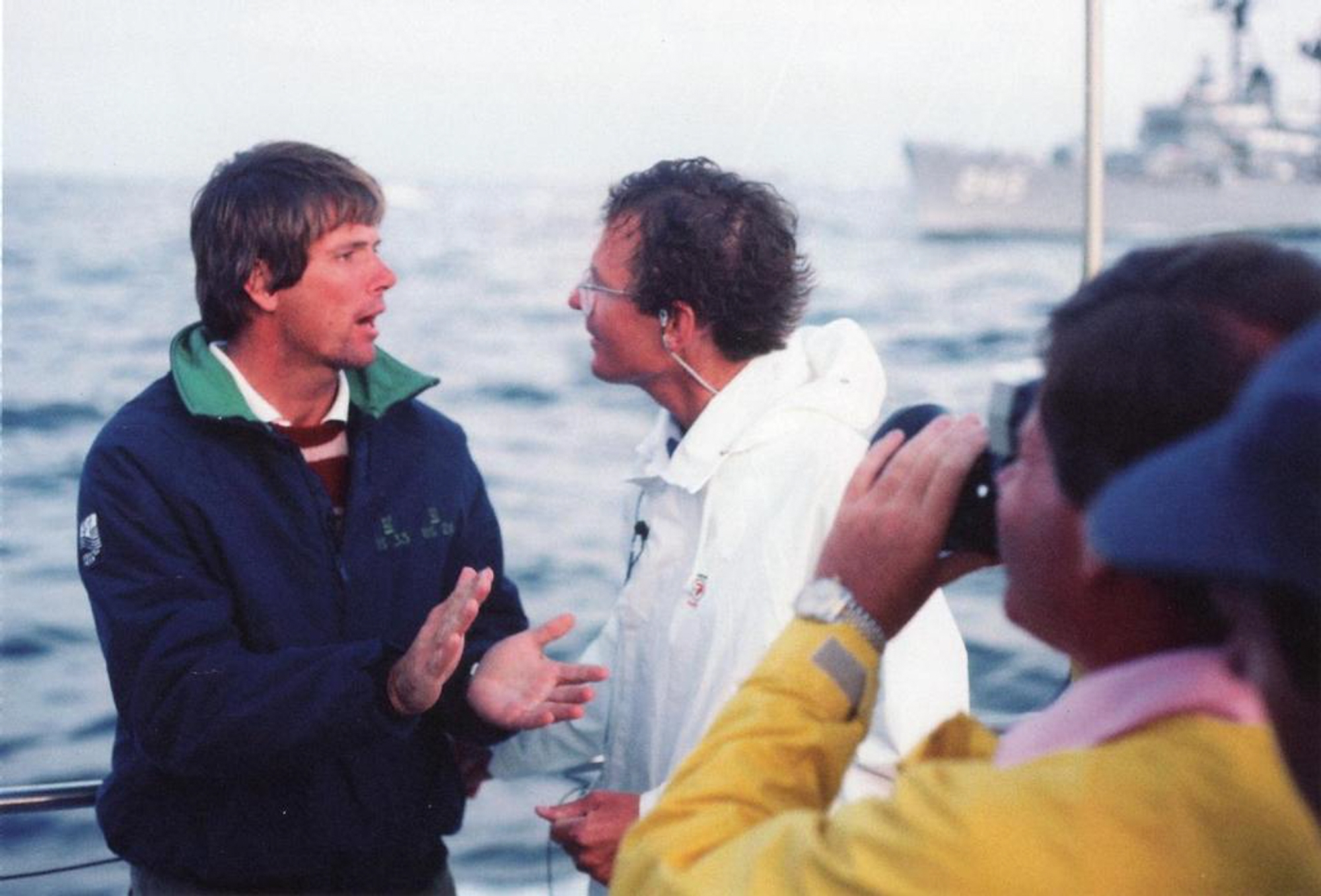
Australian reporter, Bruce Stannard (right) calls on Gary Jobson to explain tactics and strategy © Maritime Productions LLC
The reaches, so often the nemesis of Australia II, this time yielded little for Liberty who only gained on the second reach and only by five seconds. Rounding the first leeward mark, Bertrand sought to control by offering loose cover and although Conner had changed down headsail and put pressure on with a 15-tack tacking duel as the layline to the windward mark approached, the advantage was all Australia II, and she rounded the top mark with a 1 minute 11 second lead. Liberty threw everything at the run and shaved the delta down to 53 seconds at the final leeward mark and then threw the kitchen sink at Bertrand’s team with a 31 tack beat to the finish. In those conditions and with positional advantage, Australia II gained and took the winning gun, with a 1 minute 47 second delta. Australian supporters went wild. The score was 3-2 and the 1983 America’s Cup was the closest contest since the 1934 Match between Rainbow and Endeavour.
John Bertrand later noted: “The gun fires and we all feel the same fantastic sense of relief that we have broken the back of this regatta. The difference between 3-1 and 3-2 is as wide as the Nullarbor Desert.”
The Americans at match-point were a wounded beast but race six on the 22nd September 1983 was a hammer-blow to their retention efforts. In the pre-start, Conner ran deep into the box with Bertrand hot on his tail. Coming back on starboard tack, Bertrand held the windward position for a long time-on-distance effort with both boats flogging their sails and trying to foul. At the pin end of the line, Conner tacked, Bertrand matched to protect the right side of the course and with 30 seconds to go, Australia II wheeled onto starboard, holding the windward position as Liberty tacked beneath. Conner won the start. Again. And it was all America as Conner held the upper hand in the initial exchanges, but a brave call saw Australia II tack away to the left side of the course in search of breeze that Phil Smidmore, the mastman on Australia II had seen up ahead. It was a devastating call and with Liberty running a loose cover, in the slop, Australia II dialled into fresh breeze first and somehow kept way on the hull in anything but their preferred conditions.
In a classic wind split, Australia II rode into a lifting breeze on port tack with more pressure and rolled over Liberty to windward as the heavy red hull wallowed, desperate to click into the pressure that just wouldn’t come for them. A tack would have brought Conner back into the race, but he held on as Australia II to windward passed and hit the layline to the windward mark, rounding with a thumping 2 minute 29 second lead. As the wind backed further, the first reach became tight and negated any advantage that Liberty should have enjoyed whilst the second reach to the leeward mark became a square run and favoured Australia II. She rounded with an even larger margin on 3 minutes and 46 seconds.
The second beat, despite the windward mark being changed by 40° to the west, still saw further backing of the wind that favoured the Australians who had secured the windward slot and kept cover in the perfect match-racing command position. She raced up the leg, completing it in just 39 minutes and then powered down the final run to round the last leeward mark with a delta in excess of four minutes. With no passing lanes, Conner was beaten and although the finishing margin shortened to 3 minutes 25 seconds, it was a resounding win for Australia II and for the first time in the event’s history, the America’s Cup would go to a deciding seventh race. It was 3-3, the hand of history was on the shoulder of the Australians, and they knew it.
To wild scenes, a lay-day was called by Alan Bond on the 23rd September 1983 and all was set for a titanic battle dubbed ‘The Race of the Century’ on Saturday September 24th 1983, however the wind that day was a shifting 6-knots and the Race Committee Chairman, Dyer Jones, raised the abandonment flag.
During the lay-day, Conner had opted to re-ballast Liberty to try and find more speed but in the abandoned start he was unconvinced and so the Americans called a further lay-day on the 25th September to try and get the optimum mode. Bond was furious and threatened to protest as in the Australian’s view, race seven had already started but the sailors brought in match-racing ace Harold Cudmore, the affable Irishman, and Bruno Troublé for a day of pre-start practice between Australia II and Challenge 12, such was Bertrand’s determination to improve his starting that had been lacklustre throughout the Match.
Finally, on Monday 26th September 1983, the race for everything got underway. The two boats entered the starting box and loosely circled before Conner opted to tack off to the Committee Boat end of the line and set up for a long time-on-distance back in. Australia II stayed on their tail and set up in the leeward position on the lead back, and with 30 seconds to go as the boats reached down the line, Conner wheeled over to port tack and headed back unopposed to start. Australia II remained on starboard tack and started 8 seconds down but crucially sailed directly into a patch of better breeze on the left side of the course. Three minutes in and Conner tacked onto starboard, Australia II came back on port and with an obvious advantage, the Americans had no option but to tack onto port and try and tough it out on a long 20-minute leg out to the right-hand side of the course.
Further jockeying in what proved to be a long beat, saw the lead see-saw with the Australians holding an advantage of some two lengths at one point before Conner made a crucial call in the final third, went left, Bertrand didn’t cover and sailed into better pressure and an advantageous shift to round mark one with a 29 second lead. On the fast reach to the wing mark, this delta was stretched to 45 seconds but on the second reach that switched into more of a run, Australia II changed spinnaker and closed the gap to just 23 seconds ahead of the second beat. Conner was in control and with Halsey Herreshoff and Tom Whidden calling the shifts beautifully, Liberty rounded the final windward mark with a lead of 57 seconds – not enough in Conner’s view who had seen Australia II take on average a minute down every square spinnaker run.
Now came the downwind leg that defined everything.
Both boats rounded and performed bear-away spinnaker sets with Australia II setting up on the weather side, desperate to try and steal Liberty’s wind as both boats headed out on starboard gybe towards the spectator fleet. As Australia II’s wind-shadow started to take effect, Liberty gybed onto port back to the centre of the course whilst the Australians sailed on into better pressure. When Bertrand wheeled over to come back at Liberty who had gybed on a favourable shift and then back again, it was clear that Australia II was gaining ground. Conner described it later saying: “Two quick gybes and we paralleled her on port gybe. Then, as if using a propeller, or those trick wings on her keel, the boat started sailing lower and faster than we could.”
Coming into the final third of the run to the leeward mark, Australia II had held a long port gybe whilst Conner persisted in holding the left-hand side/middle of the course and it was here that a dramatic, nerve-jangling cross was called by the Australia II afterguard as Liberty came in on starboard. The Australians were a boatlength clear and seized the command position to leeward, gybing for the buoy and paralleling with Liberty. In the space of 4.4 miles, Australia II had taken 1 minute and 18 seconds out of the Americans and led by 21 crucial seconds with only one leg to the finish.
Conner was down but not out and in a stunningly aggressive final showdown, he threw 47 tacks at the Australians on that final leg but with superior manoeuvrability and the command covering position, Australia II was never going to let them pass and as they filed past the Black Knight committee boat and the gun fired, the America’s Cup became the property of the Royal Perth Yacht Club and 132 years of storied history, the longest winning streak in any sport, came to a thunderous end amidst a cacophony of sirens. Australia II was boarded by Alan Bond and the rest of the team and chaos ensued; the America’s Cup had finally been wrestled from the clutches of the New York Yacht Club in the most dramatic of fashions.
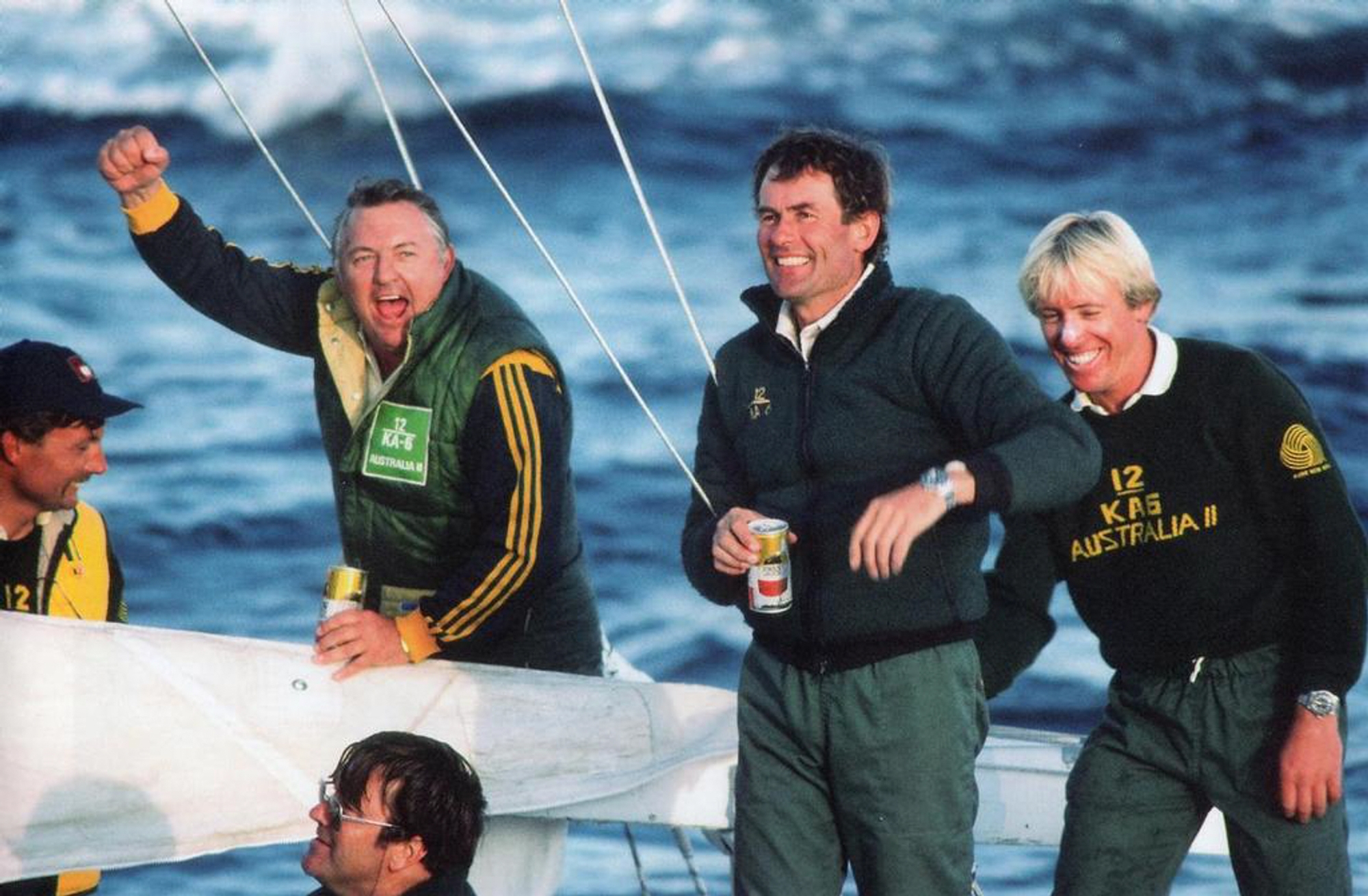
Alan Bond punches the air after Australia II wins.From left to right, John Bertrand, Alan Bond, Ben Lexcen (bottom), Hugh Treharne and Damien Frewster
Conner was downcast but gracious in defeat, congratulating the Australian team and pointing at the faster boat sailed in its perfect conditions. John Bertrand came to the press conference and delivered the line: “We were playing chess with them all summer – check, check, check, check…and today we said ‘Mate.’
That evening, the keel was revealed in typical Alan Bond style with him orchestrating the crowd’s chants and symbolically ordering the lowering of the shrouds. Iconic photos were taken. The America’s Cup would never be the same again.
At a presentation at the White House Rose Garden, President Ronald Reagan and Vice President George Bush formally handed over the America’s Cup to the Australians whilst in Australia wild scenes erupted and led to Bob Hawke, the then Prime Minister saying: “Any boss who sacks anyone for not turning up today is a bum.” The Cup was coming to Perth and the modern-day America’s Cup era had begun.
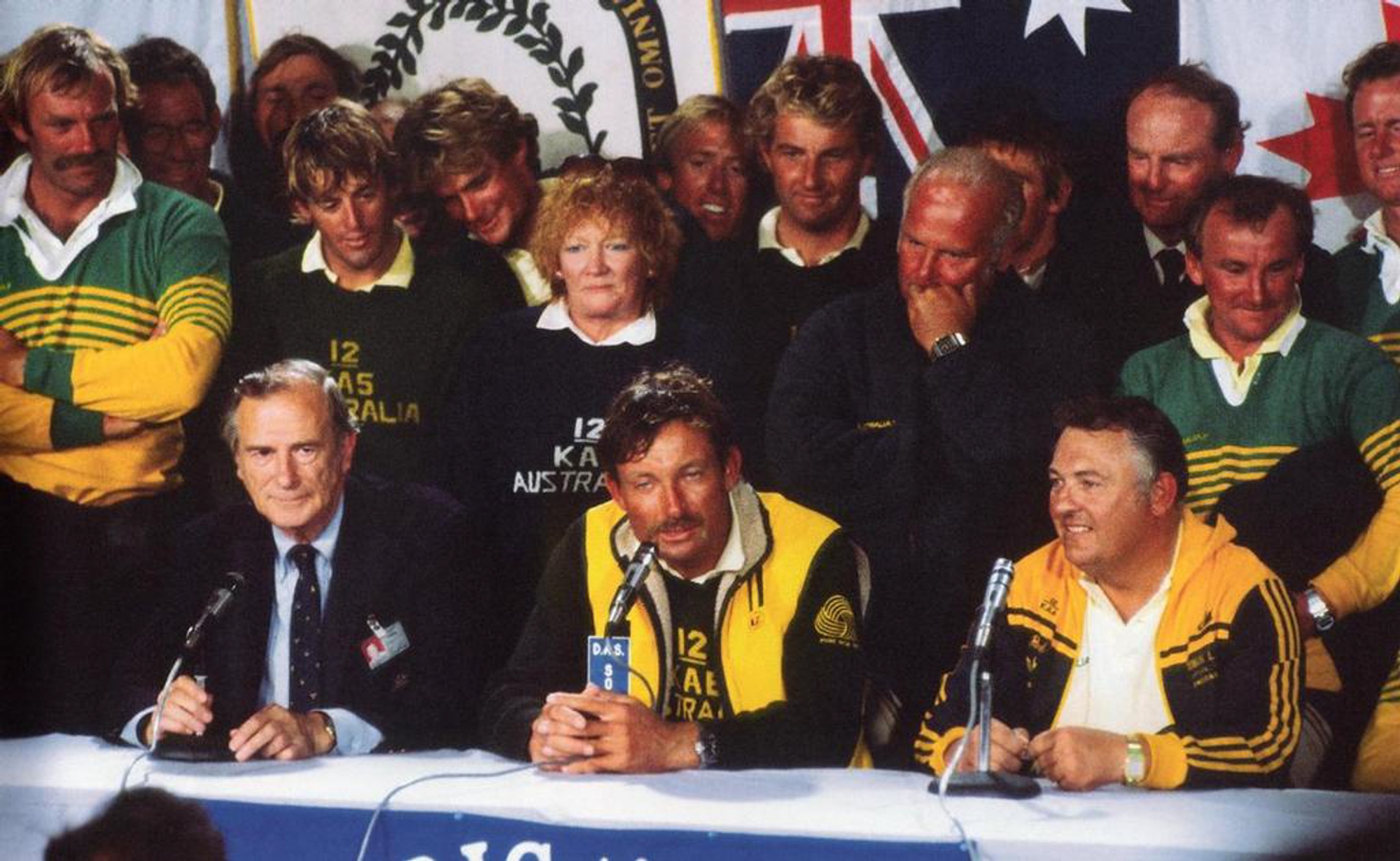
At the media conference at the State Armory, the Australia II crew were tired and subdued in victory © Maritime Productions LLC